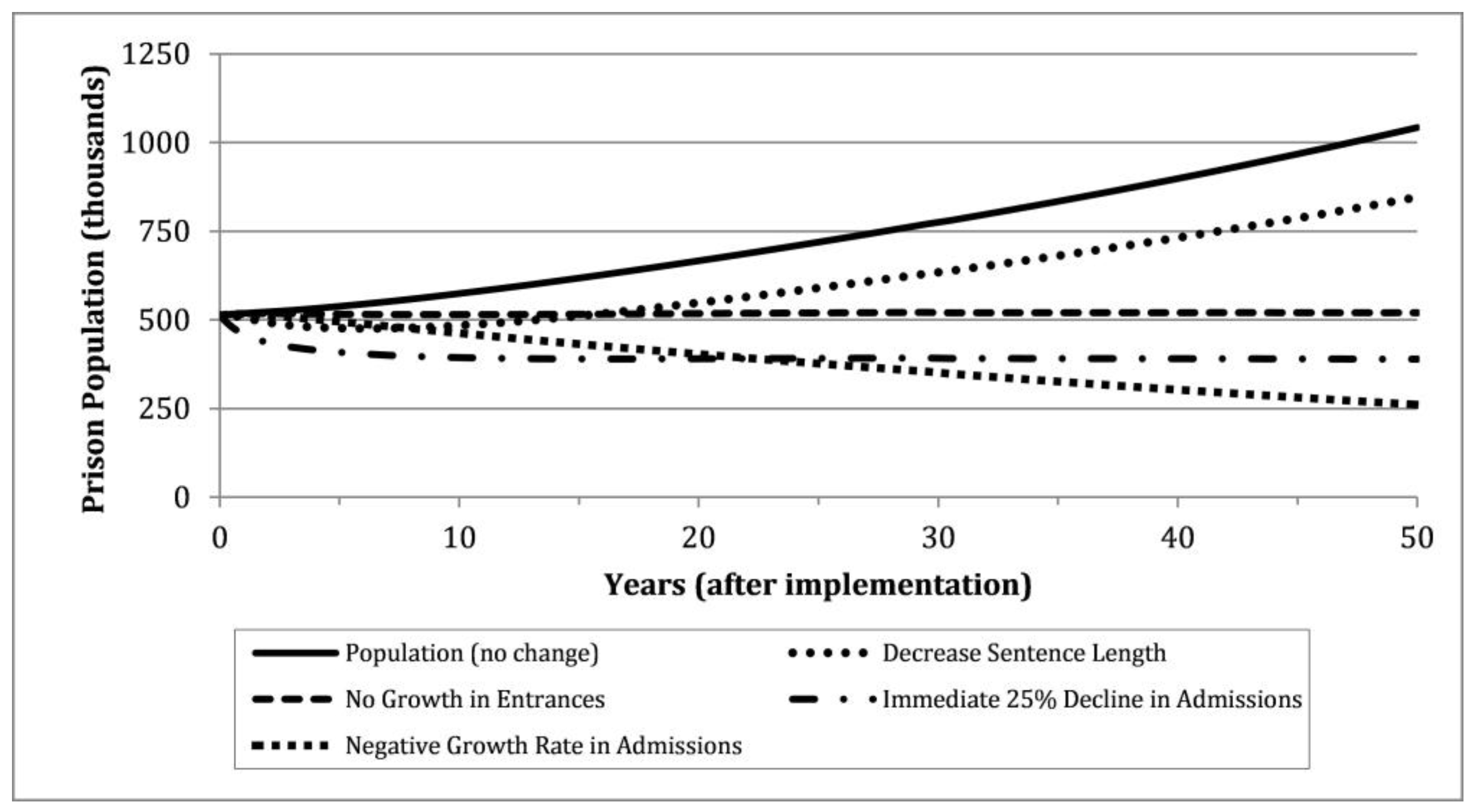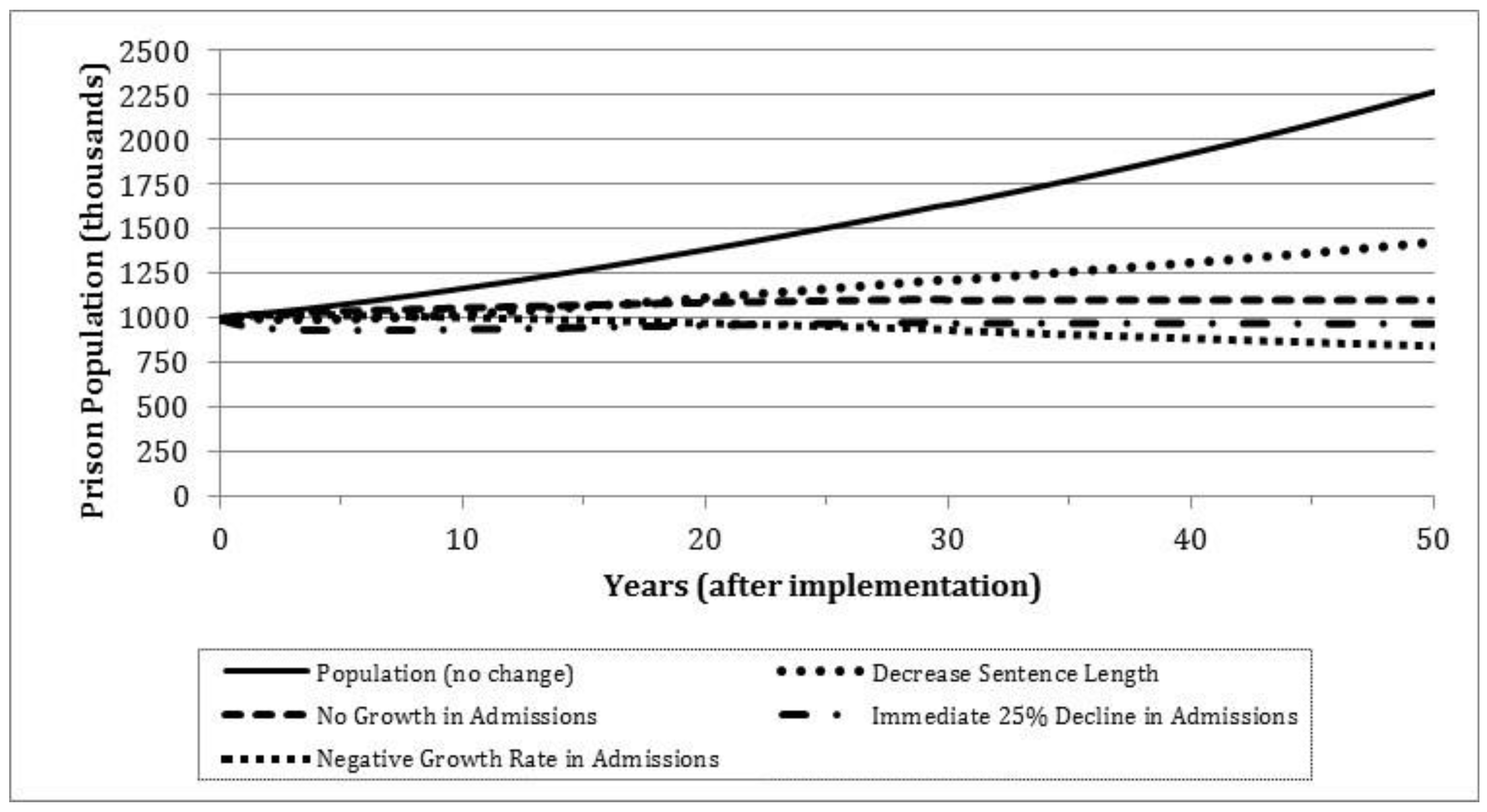The Strategies, Complexities, and Realities of Zero Prison Population Growth
Abstract
:1. Introduction
While one party argues to eliminate incarceration for some crimes and replace it with fines, warnings, drug treatment, etc., the other argues for more effective rehabilitation programs inside the prison walls, such as opportunities for inmates to advance their education. In this paper, I argue: (1) a methodological examination of punishment informed by population dynamics is necessary to understand how and why the U.S. leads the world in the size of its prison population, which will help illuminate the complexity of the punishment problem; (2) formal demography provides unique tools to evaluate the costs and effectiveness of policies proposed or in current use to slow, stop, and lower the size of the prison population.The debate over how to reverse this [problem] breaks down among those who favor broad changes to sentences, including the reduction of mandatory minimum sentences, those who want to address early release and services behind bars, and those who favor a blended approach.
1.1. The Case for Demography
1.2. Strategies to Zero Prison Population Growth
1.3. Examples of Recent Policy Reforms
- (1)
- Reducing the length of sentence and/or reclassification (from felony to misdemeanor) for some nonviolent crimes. Many states have made changes to sentencing practices. Six offenses were reclassified in California, including shoplifting, from a felony to a misdemeanor. Other states, including New Hampshire and Tennessee, now offer additional opportunities for inmates to reduce the time served for certain offenses.
- (2)
- Rerouting people who commit low-level offenses and/or violate their probation or parole from prison to rehabilitation, probation, community service, or other alternatives to incarceration. In Missouri, for example, people who commit misdemeanors classified at the lowest level are no longer subject to incarceration.
- (3)
- Decriminalizing certain offenses. For example, Alaska and Oregon have decriminalized the possession of some quantity of marijuana for recreational purposes. In Maryland and the District of Columbia, the penalty for possessing a limited amount of marijuana has been reduced to a fine.
- (4)
- Addressing the consequences of having a criminal record, such as ineligibility for some types of financial aid and/or government assistance, difficulty finding legitimate employment, and difficulty finding appropriate housing. Several states—Delaware, Illinois, Nebraska, and New Jersey—and the District of Columbia have implemented “ban the box” policies to help end employment discrimination against people with a criminal record. In 2014, California and Missouri made great strides toward successful reintegration by removing restrictions on former inmates with a drug felony record, thus enabling them to receive financial aid and public assistance.
2. Data and Methodology
2.1. Data
2.2. The Cohort Component Method and Simulating the Impact of Policies
2.3. Input Variables
2.4. Cohort-Component Mechanics
2.5. Estimating the Costs of Zero Prison Population Growth
3. Results
3.1. Modeling Changes for Individuals Incarcerated for Nonviolent Offenses
- (1)
- Examine the impact of lowering the average sentence by 20%. This translates into changing the length of sentence for people who commit nonviolent crimes.
- (2)
- Examine what happens if zero growth in admissions is achieved. This means admissions would be the same from year to year. Policy changes such as using alternatives to incarceration for some offenses might lead to this result. For example, if the year to year variation in admissions resulted from drug offenses, rerouting this group to drug courts where the penalties consisted of probation and/or some type of rehabilitation and life skills workshops would make the number of admissions to prison stationary year to year.
- (3)
- Implement an immediate 25% decrease in admissions and then hold that level constant. One way to achieve this is to decriminalize the possession/use of marijuana, within reason, and to provide alternatives to incarceration for some other nonviolent offenses.
- (4)
- Observe the results of a constant yearly decline in admissions. This could be achieved by reducing the barriers to former inmates’ reintegration into society. Many argue that these barriers are responsible for the high recidivism in the U.S. The prior section provided examples of how states are trying to ameliorate the impact of having a criminal record.
3.2. The Costs of Momentum
4. Discussion
Conflicts of Interest
References
- Austin, James. 2010. Reducing America’s Correctional Populations: A Strategic Plan. Justice Research and Policy 12: 9–40. [Google Scholar] [CrossRef]
- Austin, James, and Barry Krisberg. 1985. Incarceration in the United States: The Extent and Future of the Problem. The Annals of the American Academy of Political and Social Science 478: 15–30. [Google Scholar] [CrossRef]
- Braman, Donald. 2004. Doing Time on the Outside: Incarceration and Family Life in Urban America. Ann Arbor: University of Michigan Press. [Google Scholar]
- Bushway, D. 2004. Labor Market Effects of Permitting Employer Access to Criminal History Records. Journal of Contemporary Criminal Justice 20: 276–91. [Google Scholar] [CrossRef]
- Demeny, Paul. 1988. Social science and population policy. The Population and Development Review 14: 451–79. [Google Scholar] [CrossRef]
- Golaszewski, Paul. 2011. A Status Report: Reducing Prison Overcrowding in California. Sacramento: Legislative Analyst’s Office. [Google Scholar]
- Federal Bureau of Investigation. 2016. Crime in the United States, 2015. In Offenses Cleared; Edited by Federal Bureau of Investiation. Washington: Department of Justice. [Google Scholar]
- Hesketh, Therese, Li Lu, and Zhu Wei Xing. 2005. The Effect of China’s One-Child Family Policy after 25 Years. The New England Journal of Medicine 353: 1171–76. [Google Scholar] [CrossRef] [PubMed]
- International Centre for Prison Studies. 2017. Entire world—Prison Population Rates per 100,000 of the national population. Available online: http://www.prisonstudies.org/ (accessed on 15 May 2017).
- Knapp, Kay A., and Ronald E. Anderson. 1981. Minnesota Sentencing Guidelines Population Projection Program User Manual. St. Paul: Minnesota Sentencing Guidelines Commission. [Google Scholar]
- Kubrin, Charis, and Carrol Seron. 2016. The Prospects and Perils of Ending Mass Incarceration in the United States. The Annals of the American Academy of Political and Social Science 664: 16–24. [Google Scholar] [CrossRef]
- Lutz, Wolfgang, and Sergei Scherbov. 2002. Can Immigration Compensate for Europe’s Low Fertility? Luxembourg: International Institute for Applied Systems Analysis. [Google Scholar]
- Pager, Devah Iwalani. 2003. The Mark of a Criminal Record. American Journal of Sociology 108: 937–75. [Google Scholar] [CrossRef]
- Patterson, Evelyn J. 2013. The Dose-Response of Time Served in Prison on Mortality: New York State, 1989–2003. American Journal of Public Health 103: 523–29. [Google Scholar] [CrossRef] [PubMed]
- Patterson, Evelyn J., and Chris Wildeman. 2015. Mass Imprisonment and the Life Course Revisited: Cumulative Years Lost to Incarceration for Working-Age White and Black Men. Social Science Research 661: 86–108. [Google Scholar]
- Pfaff, John F. 2008. The Empirics of Prison Growht: A Critical Review and Path Forward. The Journal of Criminal Law and Criminology 98: 547–619. [Google Scholar]
- Pfaff, John F. 2011. The Myths and Realities of Correctional Severity: Evidence from the National Corrections Reporting Program on Sentencing Practices. American Law and Economics Review 13: 491–531. [Google Scholar] [CrossRef]
- Porter, Nicole D. 2015. The State of Sentencing 2014: Developments in Policy and Practice. Washington: The Sentencing Project. [Google Scholar]
- Preston, Samuel, Patrick Heuveline, and Michel Guillot. 2001. Demography: Measuring and Modeling Population Processes. Malden: Blackwell Publishers Inc. [Google Scholar]
- Pritchett, Lant H. 1994. Desired fertility and the impact of population policies. Population and Development Review 20: 1–55. [Google Scholar] [CrossRef]
- Raphael, Steven. 2009. Explaining the rise in U.S. incarceration rates. Criminology and Public Policy 8: 87–95. [Google Scholar] [CrossRef]
- Steinhauer, Jennifer. 2015. Bipartisan Push Builds to Relax Sentencing Laws. Available online: https://www.nytimes.com/2015/07/29/us/push-to-scale-back-sentencing-laws-gains-momentum.html?_r=0 (accessed on 29 July 2015).
- Tonry, Michael. 2014. Remodeling American Sentencing: A Ten-Step Blueprint for Moving Past Mass Incarceration. Criminology and Public Policy 13: 503–33. [Google Scholar] [CrossRef]
- Travis, Jeremy, Bruce Western, and Steve Redburn. 2014. The Growth of Incarceration in The United States: Exploring Causes and Consequences. Washington: National Academy Press. [Google Scholar]
- Verma, Anjuli. 2016. A Turning Point in Mass Incarceration? Local Imprisonment Trajectories and Decarceration under California’s Realignment. The Annals of the American Academy of Political and Social Science 664: 108–35. [Google Scholar] [CrossRef]
- Visher, Christy A., and Jeremy Travis. 2003. Transitions from Prison to Community: Understanding Individual Pathways. Annual Review of Sociology 29: 89–113. [Google Scholar] [CrossRef]
- Western, Bruce. 2002. The Impact of Incarceration on Wage Mobility and Inequality. American Sociological Review 67: 526–46. [Google Scholar] [CrossRef]
| 1 | The 33 states used are Alabama, California, Colorado, Florida, Georgia, Hawaii, Iowa, Kentucky, Louisiana, Maryland, Michigan, Minnesota, Missouri, Nebraska, Nevada, New Hampshire, New Jersey, New York, North Carolina, Oklahoma, Oregon, Pennsylvania, Rhode Island, South Carolina, South Dakota, Tennessee, Texas, Utah, Virginia, Washington, West Virginia, and Wisconsin. |
| 2 | Please contact the author for access to a tool that calculates the short—and long—term consequences of policies on the size of the prison population. |



| Strategy | Time to Reach Zero or Negative Growth in Prison Population | Current Costs (in dollars) | Additional Costs at Zero Growth b (in dollars) | Total Costs to Achieve Zero Growth c (in dollars) |
|---|---|---|---|---|
| No Growth in Nonviolent Admissions | 30 years | 45 billion | 4.7 billion | 1.42 trillion |
| Negative Growth in Nonviolent Admissions | 2.5 years | 960 million | 75.6 billion | |
| Immediate 25% Decline in Nonviolent Admissions, Followed by No Growth in Nonviolent Admissions | 0 years | - | - | |
| Decrease in Sentence Length | Will Not Occur | 54.8 billion | 1.5 trillion | |
| No Change | Will Not Occur | 73.8 billion | 1.7 trillion |
© 2017 by the author. Licensee MDPI, Basel, Switzerland. This article is an open access article distributed under the terms and conditions of the Creative Commons Attribution (CC BY) license (http://creativecommons.org/licenses/by/4.0/).
Share and Cite
Patterson, E.J. The Strategies, Complexities, and Realities of Zero Prison Population Growth. Soc. Sci. 2017, 6, 60. https://doi.org/10.3390/socsci6020060
Patterson EJ. The Strategies, Complexities, and Realities of Zero Prison Population Growth. Social Sciences. 2017; 6(2):60. https://doi.org/10.3390/socsci6020060
Chicago/Turabian StylePatterson, Evelyn J. 2017. "The Strategies, Complexities, and Realities of Zero Prison Population Growth" Social Sciences 6, no. 2: 60. https://doi.org/10.3390/socsci6020060





